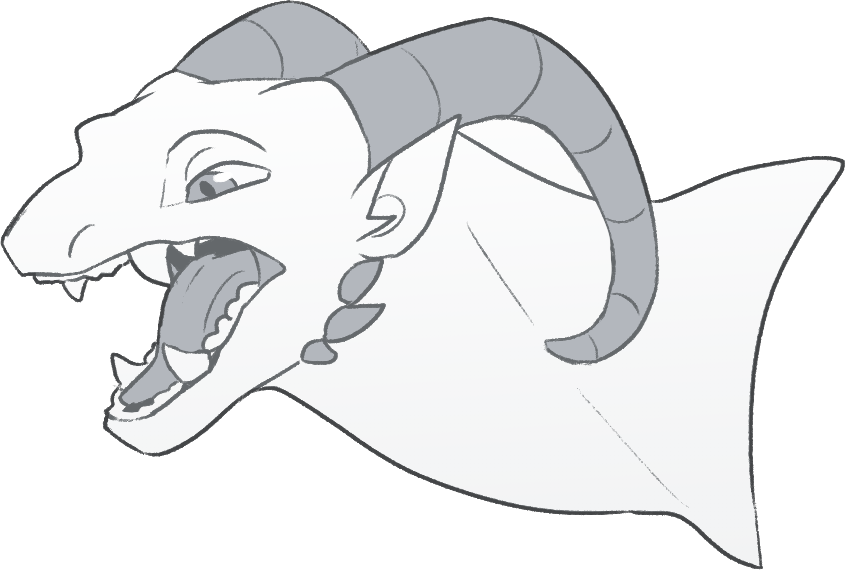
Drakes are the smallest shapeshifting race of Arcardia, but do not let their size fool you - they are quite robust and powerful. They are most known for their incredible resistance to arid biomes, having an ability to go without water for up to two weeks- as well as and their tough, fireproof scaling - Drakes are quite the hardy bunch.
Despite their title, however, drakes are among the most common of races in Arcardia, only ‘forgotten’ since they are largely ostracised by the dragons... despite them being the original inhabitants of Arcardia before it was colonised by Anerc Katafygio (Anerc). Drakes that reside in Anerc are often working lower class jobs and generally struggle to get by. They're often viewed by the elite as bone-headed and quick to violence.
Drakes are a desert adapted race with a focus on being quite tanky, despite their size. They have large clawed feet and hands, strong tails, tough scaling, and thick skulls built to withstand heavy impacts. Their scales, like their horns, are rough and well known for their fire resistance. Drakes are just a physically strong race, it’s hard to get through their scaling, and even their skin in their common forms are a little tougher than other races. They are also naturally bulkier, regardless of sex.
Drakes don’t vary as much as some other races. They're always covered in scales, and they usually have osteoderms running down their back and tail- sometimes spines or spikes as well. They can have these spikes on their arms, jaw (under their ears), or legs as well. Their tails can sometimes have a club at the end, or spikes, creating something of a thagomizer. Their tails are rather stiff, making them formidable weapons. Their ears are small and they only ever have one pair of horns with a rough, segmented appearance. Some Drakes can also have tusks, and if not that, usually they have some large, blunted, teeth sticking out of their mouths. Some drakes can also have a sickle claw on their foot, like that of a raptor. In terms of colouration, drakes have more natural or desaturated colours, like browns or oranges, reds, greys, and blue-ish silvers.

In their common forms drakes carry over their; hands/forearms, legs, tail, horns, and ears. Their eyes appear the same in both forms (white sclera, average sized iris, and rounded pupil), and their tusks can sometimes carry over as well, but often greatly redused in size. The rest of their teeth are the same in both forms (mostly flat with some blunt canines), and their tongue is rounded.
habitat ▸ Drakes are a species adapted to harsh environmental pressures, specifically to the arid deserts of Arcardia. They can go without water for up to two weeks, unlike other races that usually can't last more than three days without it. Drakes are also relatively good at traversing and climbing cliffy landscapes.
diet ▸ Despite what their appearance may suggest, drakes are primarily herbivorous, eating a variety of plants and sometimes meat opportunistically, since their environment makes it hard to find sufficient vegetation, at times.
FIRE RESISTANCE ▸ Drakes scales have a natural fire resistance. They can still get burnt, but it takes significantly longer than other races. Their scales and skin are in general quite difficult to break through.
bulldozers ▸ In nature, drakes would rely on numbers and their more defensive build to ward off predators. They aren't very fast runners compared to other races in their size range, but they're tanky, and much heavier than they first appear. Drakes have thick skulls that are built to withstand some heavy impacts, allowing them to ram and headbutt things quite effectively. Don't think you're safe if you've locked the door, a drake will make quick of that problem. They can also have all sorts of spikes or clubs on their tail, or nothing at all. Either way, you don't want to be hit by the tail of a drake. They're quite powerful and naturally stiff, making them perfect for being used as a bat.
Drakes are a species suited for dry and hot climates, or at least these drakes are. Their technical name is the Southern Drake, but it has fallen out of use due to the fact that they are the only type of drake left. There has been evidence uncovered, and histories spoken, about various other species of drake that thrived in many different biomes - most notably being the northern drake, a species that lived in the cold north regions of Gia. They had thick coats of fur on many parts of their bodies and a larger build. This species, as well as all the other variants, have sadly been lost to The Pale.
